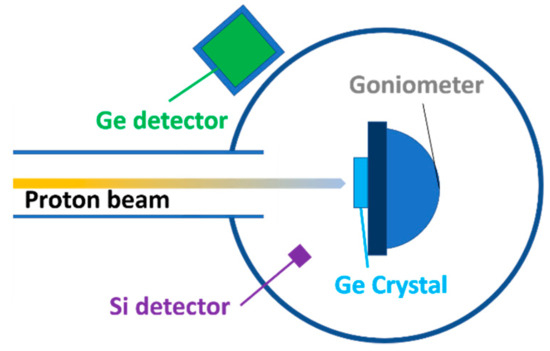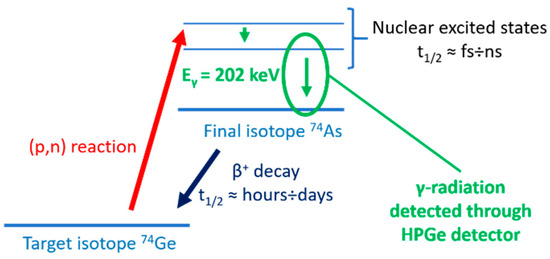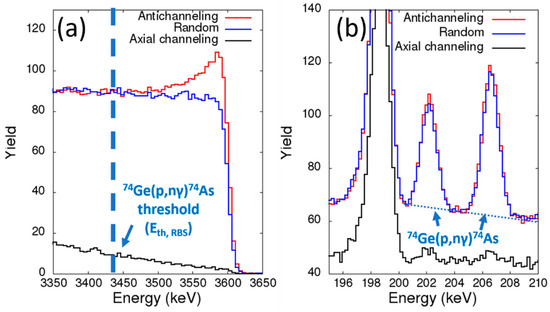Abstract
The production techniques of radioisotopes for medical purposes is a valuable and important field in nuclear medicine. In particular, the expensive cost of the prime materials for the production via cyclotron obliges the search for new solutions to enhance the production rate with minor upgrades of the current instrumentation. Oriented ordered structure can modify particle trajectories inside a medium leading to a sensible variation of the interaction rate with atomic nuclei. Under specific orientations of the target with respect to the incident beam, the probability of inelastic interaction with nuclei can be enhanced with respect to the standard rate. This effect is called anti-channeling and leads to an increase of the radioisotope production yield. A dedicated set of experimental measurements were carried out at the CN accelerator of the INFN Legnaro Laboratories to investigate nuclear reactions under channeling experiments. In particular, the production of the Arsenic-74 radioisotope through a proton beam delivered to a natural single-crystal Germanium target was monitored via γ-spectroscopy of the prompt γ-rays upon de-excitation of produced nuclei, in order to quantify the production rate variation as a function of the incident angle.
1. Introduction
The current wealth of radioisotopes has been made possible especially through nuclear reactors. This allowed the development of several applications in modern nuclear medicine, biology, and other fields. At the same time, great efforts have been made for the development of accelerators devoted to the production of radioisotopes [1]. Indeed, production through accelerators is spreading worldwide, despite its higher cost with respect to the production via nuclear reactors, due to some advantages such as the high specific activity that can be obtained through the (p,xn) and (p,α) reactions, the smaller amount of radioactive waste, and the possibility to produce radioisotopes very close to hospitals in compact facilities.
In this contest, the research of new technological solutions to obtain a more efficient radioisotope production is of special interest. One possible way to improve production efficiency with a minor upgrade of the existing technology is the usage of a crystalline target. Indeed, ordered and oriented structures, such as crystals, can modify the trajectories of incoming beam particles interacting with them. Compared to the motion into an amorphous medium, ions interacting with a crystal are subject to coherent interactions due to the periodicity of the atoms in the crystalline structure. This phenomenon is capable of modifying particle trajectories inside the medium, causing the variation of the interaction rate with the atomic nuclei.
An interesting effect can be observed when charged particles enter a crystal at an angle close to the critical angle for channeling θC with respect to an atomic plane [2] (, which depends on the interplanar potential well with depth U, and the particle energy E). In such a case, almost all the beam particles, even those entering in the middle of two planes, undergo a motion above the maxima of the potential barriers, where the nuclei of the lattice atoms are located, thus resulting in a higher probability of interaction with nuclei with respect to the motion into an amorphous medium with the same density [3]. In particular, the enhancement of the 18O(p,α)15N reaction obtained with protons at 642.5 keV (i.e., just above a sharp resonance at 628 keV) impinging a Al2O3 crystal has been observed through a dedicated experiment performed at the INFN-Legnaro Laboratories [4]. This result suggested the development of a crystalline target for the production of radioisotopes of interest for medical applications. In this paper, a measurement of the enhancement of the production of the Arsenic-74 isotope, which is used in tumor imaging [5], via the 74Ge(p,n)74As reaction in antichanneling condition, is shown.
2. The Experimental Setup
The LNL-CN is a Van Der Graaf electrostatic accelerator with a maximum voltage terminal of 5.5 MV, thus being ideal for investigating nuclear reactions in the first layers of a material. As shown in Figure 1, a rectangular Ge sample (10x10x1 mm, with the main surface oriented along the (111) crystallographic planes) is installed onto a goniometer with angular resolution of 0.01° and a minimum pressure inside the chamber of approximately 10-7 mbar. This goniometer allowed the alignment of the crystal axis with respect to the incoming beam, to study the transition from channeling to antichanneling condition. Beam divergence and goniometer resolution—both of the order of 0.01°—are perfectly suitable for channeling studies at these energies, taking into account that θC for channeling between Ge (100) planes for 4 MeV protons is of the order of 0.2°.

Figure 1.
Experimental setup. A proton beam is delivered by the LNL-CN accelerator to a germanium single crystal installed onto a goniometer. Backscattered protons are detected through a silicon detector, while the γ-radiation is measured through a HPGe detector.
The alignment of the samples was done through a silicon detector for Rutherford Backscattering analysis (RBS), i.e., by measuring the backscattered particles as a function of the angle between the beam and the samples. The RBS detector was placed at 115 mm and at an angle of 160° from the target. A HPGe detector was placed outside the chamber in order to measure the prompt γ-radiation emitted by the target during the irradiation with the proton beam.
The beam energy was set at 3.80 MeV, i.e., a value slightly above the threshold of production of the Arsenic-74 radioisotope through the 74Ge(p,n)74As reaction, in order to confine the production of the radioisotope in the first few micrometers of thickness of the target, where the antichanneling effect is concentrated. The amount of 74As produced can be determined by considering the prompt γ-rays from the low-lying excited states of the 74As in the measured γ-spectra. The scheme of the nuclear reaction and of the γ-radiation studied is shown in Figure 2.

Figure 2.
Scheme of the nuclear reaction studied. Prompt γ-radiation from the low-lying 202 keV state of 74As is measured through the HPGe detector to determine online the 74As production rate.
3. Results
Firstly, the threshold energy for protons for populating the low-lying excited levels of Arsenic-74 was determined. For this purpose, measurements of the γ-spectra for a proton beam at different energies (3.75, 3.80 and 3.85 MeV) were performed. In particular, by looking at the integral of the γ-peak at 202 keV (see Fig. 3b, as an example, the γ-spectrum for protons at 3.80 MeV) emitted by the excited 74As we extrapolated a threshold energy ETh = 3.72±0.01 MeV. This result allowed to find the maximum depth for the production reaction through protons incident at EIn = 3.80 MeV by means of a simulation of the energy loss of protons into germanium via SRIM software, obtaining a depth dTh, Ein=3.80 keV = 2.75±0.05 μm. Then, those protons which suffer backscattering into the target as they are at the threshold energy, will reach the Si detector having an energy of ETh,RBS = 3.44±0.01 MeV. As shown in Fig. 3(a), after finding the alignment for axial channeling condition in which backscattering is at its minimum (black line), a comparison of the integral of the RBS spectra above the ETh,RBS energy shows an enhancement in backscattering efficiency in antichanneling condition of 9.1±0.3% with respect to the randomly oriented case. At the same time, the integral of the 202-keV peak (see Figure 3(b)) shows that the production of the 74As in antichanneling is increased of the 9.8 ± 0.6% with respect to the random case.

Figure 3.
Rutherford Backscattering of protons incident at 3.80 MeV (RBS, a) and γ-radiation (b) measured online at different alignment conditions (antichanneling, random orientation, axial channeling). Yield is normalized to 1 μC of incoming protons.
4. Conclusions
In this work, the enhancement of the production of a radioisotope for medical applications due to the antichanneling effect is shown. The measurement was performed through γ-spectroscopy online, i.e., during the irradiation of the target with a proton beam, after performing the alignment of the target by means of the Rutherford Backscattering of the proton beam. In particular, the increase of the amount of backscattered protons above the reaction threshold in antichanneling condition with respect to the case of a randomly oriented target is found to be in good agreement with the enhancement of the production of the Arsenic-74 radioisotope, as one can observe looking at the 202 keV line in the γ-spectra. Both the effects are due to the higher nuclear density experienced by the beam particles undergoing the quasi-channeled motion. This result confirms the possibility to improve the production of radioisotopes for medical applications via antichanneling.
Funding
We acknowledge the financial support of the European Regional Development Fund through the POR-FESR 2014-2020 programme (INFN-TTLAB TROPIC project, CUP I32F17000440002) and of the INFN CSNV-GECO project.
References
- Schmor, P. Review of Cyclotrons for the Production of Radioactive Isotopes for Medical and Industrial Applications. Rev. Accelerator Sci. Technol. 2012, 4, 103–116. [Google Scholar] [CrossRef]
- Lindhard, J. Influence of crystal lattice on motion of energetic charged particles. Kongel. Dan. Vidensk. Selsk. Mat.-Fys. Medd. 1965, 34. Available online: http://gymarkiv.sdu.dk/MFM/kdvs/mfm%2030-39/mfm-34-14.pdf (accessed on 1 August 2019).
- Smulders, P.J.M.; et al. Giant focusing peak and potential dependence observed in a transition from axial to planar channeling in Si. Nucl. Instr. and Meth. in Phys. Res. B 1992, 67, 185–188. [Google Scholar] [CrossRef]
- Bagli, E.; de Salvador, D.; Bacci, L.; Sgarbossa, F.; Bandiera, L.; Camattari, R.; Germogli, G.; Mazzolari, A.; Sytov, A.; Guidi, G. Enhancement of the Inelastic Nuclear Interaction Rate in Crystals via Antichanneling. Phys. Rev. Lett. 2019, 123, 044801. [Google Scholar] [CrossRef] [PubMed]
- Jennewein, M.; Lewis, M.A.; Zhao, D.; Tsyganov, E.; Slavine, N.; He, J.; Watkins, L.; Kodibagkar, V.D.; O’Kelly, S.; Kulkarni, P.; et al. Vascular Imaging of Solid Tumors in Rats with a Radioactive Arsenic-Labeled Antibody that Binds Exposed Phosphatidylserine. Clin. Cancer Res. 2008, 14, 1377–1385. [Google Scholar] [CrossRef] [PubMed]
© 2019 by the authors. Licensee MDPI, Basel, Switzerland. This article is an open access article distributed under the terms and conditions of the Creative Commons Attribution (CC BY) license (http://creativecommons.org/licenses/by/4.0/).